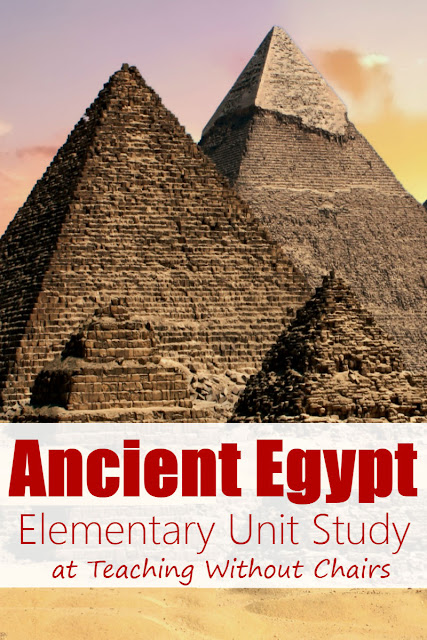Pyramid Science & STEM (Ancient Egypt Homeschool Unit Study Day 5)
This pyramid science/STEM lesson is Day 5 in the Ancient Egyptian Class or Unit Study for homeschoolers. This lesson is designed for children in grades 1-6.
Ancient Egypt Unit Study Day 5:
Pyramid Science & STEM
Length: 40-70 minutes (Our class was 60 minutes long, and that was perfect for this day!)
Goals: Students will use logic, reasoning, and combined STEM skills to discuss an ancient Egyptian mystery and compete in a friction themed Egyptian-inspired contest!
Lesson Outline (details below):
1- Friction Dilemma
2- Likely Solution
3- STEM Challenge
4- Clean up & Review
2- Likely Solution
3- STEM Challenge
4- Clean up & Review
Supplies:
* recyclable materials (I used egg carton lids, cardboard, paper, and fabric)
* tape
* glue sticks
* magnets, nuts, and bolts (optional, but I wanted to provide something heavy for the kids)
* 1-2 ramps (I used a board about 2 feet x 3 feet)
* timer/stop-watch
* optional: limestone & granite bricks (these cost $1-3 at a hardware/garden store)
* optional: a bin with sand in it
* optional, but really good Video 1: https://www.youtube.com/watch?v=UByQPHNyqyk
* optional, but really good Video 2: https://www.youtube.com/watch?v=52V9jmrgSbI
Detailed Lesson:
Preparation:
* Gather supplies. I cut the egg carton lids in half to represent sleds.
* Load videos, if you choose to use them.
* Set up the ramp. You want it just steep enough that an empty egg carton will quickly slide down it.
* Load videos, if you choose to use them.
* Set up the ramp. You want it just steep enough that an empty egg carton will quickly slide down it.
Lesson (with your kiddos!):
1- Explain: The ancient Egyptians had a problem. They designed these huge pyramids to bury their kings and honor their religion, BUT the stones they planned on using were limestone and granite. These are heavy stones! Show a limestone and granite brick--let the kids hold them. These are tiny stones! The stones the Egyptians used were made of the same rocks, but as big as a whole room! The Great Pyramid used more than 2 million stones! The biggest granite stones weighed more than 150,000 pounds and came from quarries 500 miles away!
2- Ask: How do you think they moved such large, heavy stones so far? There was no river that went along that distance--they could not float the stones. There were no wheels invented--they could not "roll" them. Wait until someone suggests pulling or pushing them.
3- Discuss! Pulling and pushing these stones would have been a ton of work, but it seems like the most likely method. There was one other problem though. Imagine dragging a sled with a super heavy stone on it across a sandy desert. What would the sand do? (Pile up in front of the sled.) (If you have the optional sand bin, you can demonstrate this by pushing an egg carton sled along the sand.) How could you stop it from building up? They may not figure this one out...Egyptologists only came up with this theory around 2014! But you can give them clues...like this picture:
This drawing was originally made in color on the walls of Djehutihotep's tomb. It shows workers transporting a statue. Do you see what's happening right in front of the statue? It looks like someone is pouring water on the sand in front of the sled!
The right amount of water would make the sand more compact, easier to slide a sled on, and reduce the friction between the sled and the sand.
Watch Optional Video #1 for a nice visual of the process!
4: STEM Challenge: The ancient Egyptians needed to decrease friction enough to slide their sleds along the sand. What is friction? A force that opposes, or is the opposite of, motion. Any time you have moving parts, you have friction! We are going to have a friction contest! I have these lovely egg carton sleds and this ramp. The sleds slide down the ramp so quickly that you really have no control over them. Your challenge is to INCREASE friction enough that your sled is the slowest to go down the ramp, BUT not so much that your sled doesn't still slide down the ramp!
Show the kids their supply choices, and let them get to work!
I limited them using the class time length...we had to have time to time everyone's sled and clean up (I try to give us about 10 minutes to clean). It worked out perfectly. We actually had a couple kids finish early, so we started timing them as they announced they were done!
Every single sled was so unique! Here are a couple:
And, of course, timing them was a ton of fun!
5: Optional Video #2: If you have time, this is a FANTASTIC video showing how the pyramids were built!
6: Clean up! I told them they could keep any recyclable material, but I wanted all nuts, bolts, and magnets back.
2- Ask: How do you think they moved such large, heavy stones so far? There was no river that went along that distance--they could not float the stones. There were no wheels invented--they could not "roll" them. Wait until someone suggests pulling or pushing them.
3- Discuss! Pulling and pushing these stones would have been a ton of work, but it seems like the most likely method. There was one other problem though. Imagine dragging a sled with a super heavy stone on it across a sandy desert. What would the sand do? (Pile up in front of the sled.) (If you have the optional sand bin, you can demonstrate this by pushing an egg carton sled along the sand.) How could you stop it from building up? They may not figure this one out...Egyptologists only came up with this theory around 2014! But you can give them clues...like this picture:
This drawing was originally made in color on the walls of Djehutihotep's tomb. It shows workers transporting a statue. Do you see what's happening right in front of the statue? It looks like someone is pouring water on the sand in front of the sled!
The right amount of water would make the sand more compact, easier to slide a sled on, and reduce the friction between the sled and the sand.
Watch Optional Video #1 for a nice visual of the process!
4: STEM Challenge: The ancient Egyptians needed to decrease friction enough to slide their sleds along the sand. What is friction? A force that opposes, or is the opposite of, motion. Any time you have moving parts, you have friction! We are going to have a friction contest! I have these lovely egg carton sleds and this ramp. The sleds slide down the ramp so quickly that you really have no control over them. Your challenge is to INCREASE friction enough that your sled is the slowest to go down the ramp, BUT not so much that your sled doesn't still slide down the ramp!
Show the kids their supply choices, and let them get to work!
I limited them using the class time length...we had to have time to time everyone's sled and clean up (I try to give us about 10 minutes to clean). It worked out perfectly. We actually had a couple kids finish early, so we started timing them as they announced they were done!
Every single sled was so unique! Here are a couple:
5: Optional Video #2: If you have time, this is a FANTASTIC video showing how the pyramids were built!
6: Clean up! I told them they could keep any recyclable material, but I wanted all nuts, bolts, and magnets back.
7: Review what they've learned and their favorite parts of the day.
Did you enjoy this lesson? I'd love to hear from you!!
Click here for the rest of the Ancient Egyptian Unit Study / Class! Alternatively, you can buy the entire set here on TpT.
And if you're looking for more homeschool unit studies, be sure to check out our growing collection here!
Happy Educating!
Carla






















0 comments